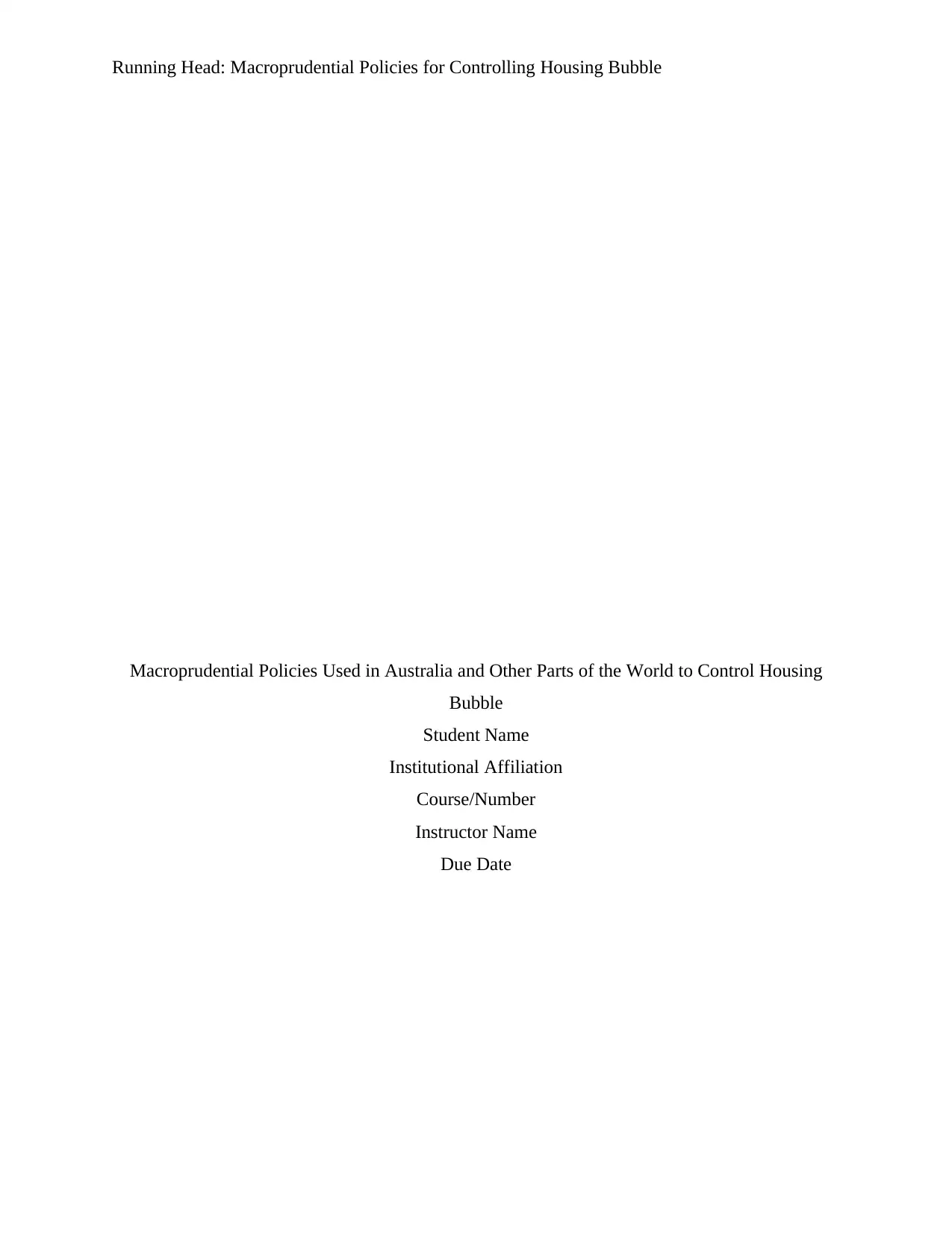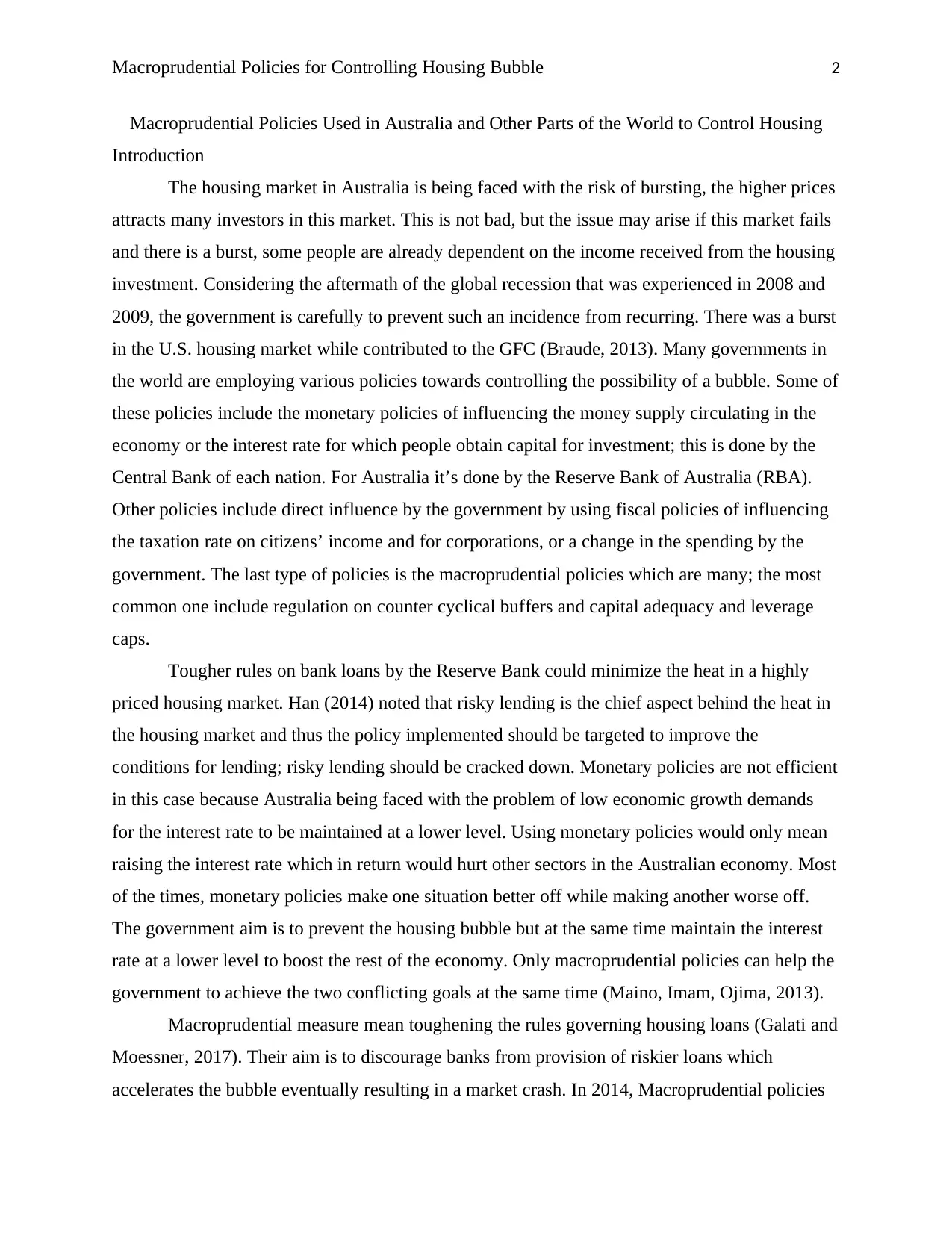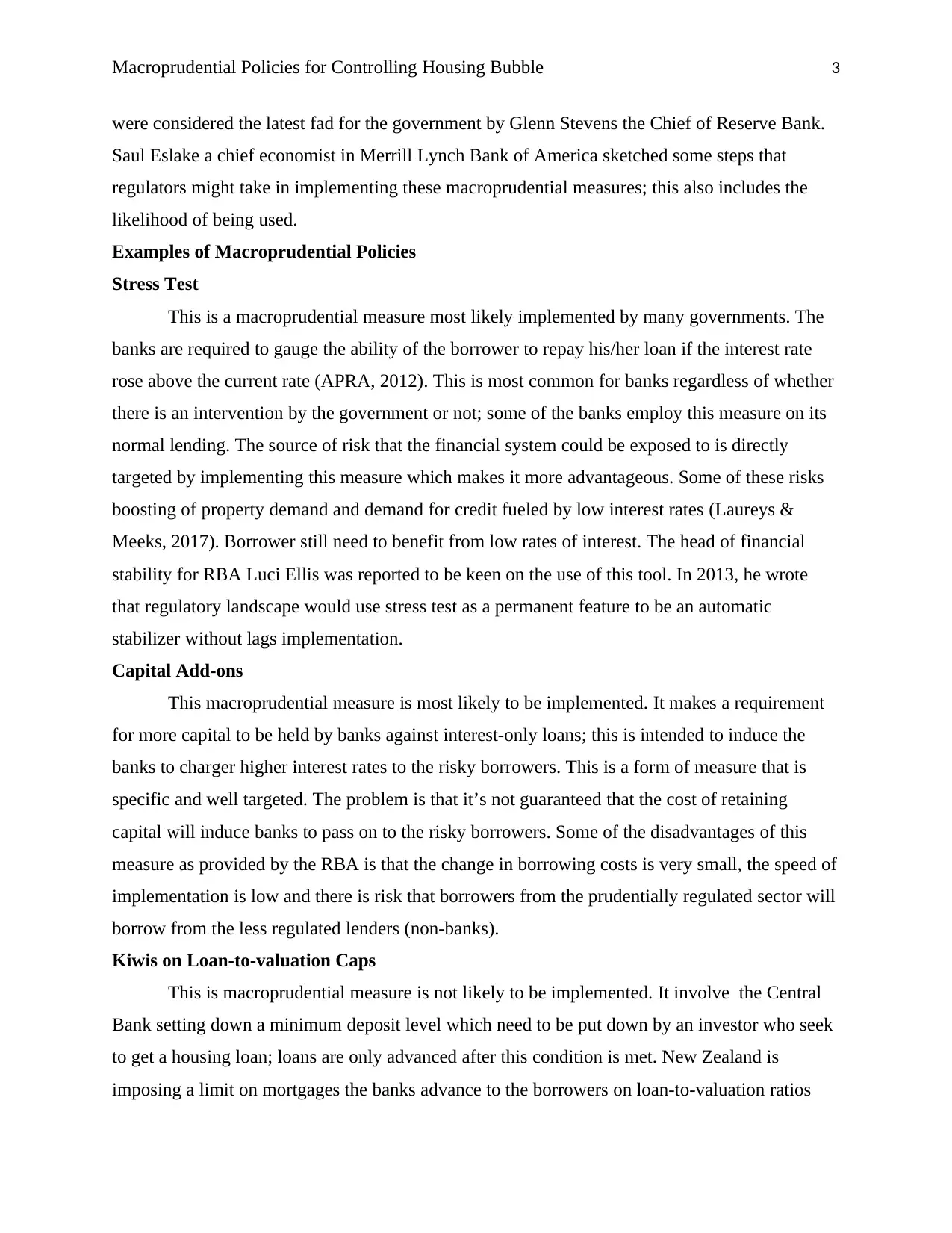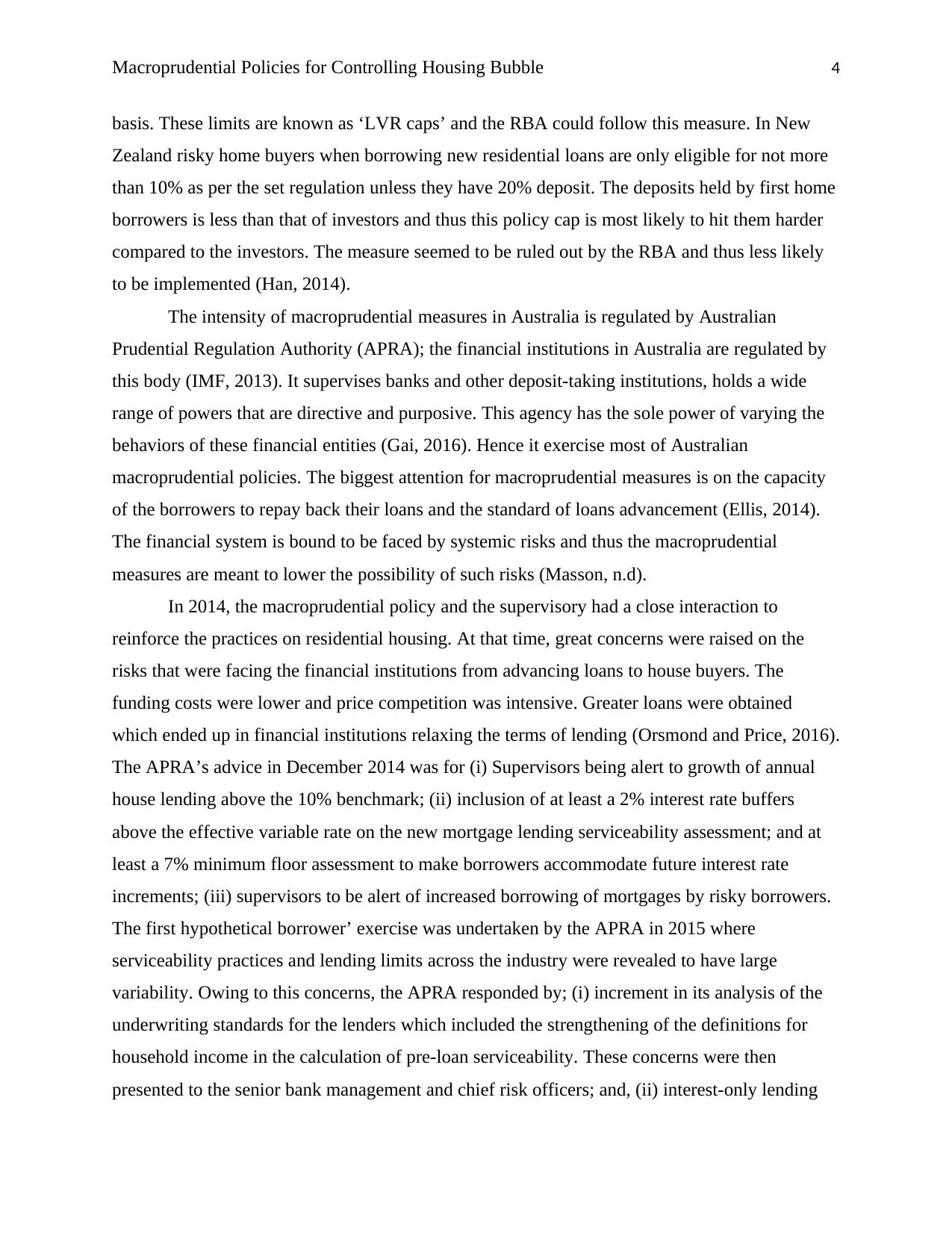Macroprudential Policies for Controlling Housing Bubble 2 Running Head
VerifiedAdded on 2021/06/15
|6
|1990
|369
AI Summary
Macroprudential Policies for Controlling Housing Bubble 2 Running Head: Macroprudential Policies for Controlling Housing Bubble Macroprudential Policies Used in Australia and Other Parts of the World to Control Housing Bubble Student Name Institutional Affiliation Course/Number Instructor Name Due Date Macroprudential Policies Used in Australia and Other Parts of the World to Control Housing Introduction The housing market in Australia is being faced with the risk of bursting, the higher prices attracts many investors in this market. Some of these policies
Contribute Materials
Your contribution can guide someone’s learning journey. Share your
documents today.

Running Head: Macroprudential Policies for Controlling Housing Bubble
Macroprudential Policies Used in Australia and Other Parts of the World to Control Housing
Bubble
Student Name
Institutional Affiliation
Course/Number
Instructor Name
Due Date
Macroprudential Policies Used in Australia and Other Parts of the World to Control Housing
Bubble
Student Name
Institutional Affiliation
Course/Number
Instructor Name
Due Date
Secure Best Marks with AI Grader
Need help grading? Try our AI Grader for instant feedback on your assignments.

Macroprudential Policies for Controlling Housing Bubble 2
Macroprudential Policies Used in Australia and Other Parts of the World to Control Housing
Introduction
The housing market in Australia is being faced with the risk of bursting, the higher prices
attracts many investors in this market. This is not bad, but the issue may arise if this market fails
and there is a burst, some people are already dependent on the income received from the housing
investment. Considering the aftermath of the global recession that was experienced in 2008 and
2009, the government is carefully to prevent such an incidence from recurring. There was a burst
in the U.S. housing market while contributed to the GFC (Braude, 2013). Many governments in
the world are employing various policies towards controlling the possibility of a bubble. Some of
these policies include the monetary policies of influencing the money supply circulating in the
economy or the interest rate for which people obtain capital for investment; this is done by the
Central Bank of each nation. For Australia it’s done by the Reserve Bank of Australia (RBA).
Other policies include direct influence by the government by using fiscal policies of influencing
the taxation rate on citizens’ income and for corporations, or a change in the spending by the
government. The last type of policies is the macroprudential policies which are many; the most
common one include regulation on counter cyclical buffers and capital adequacy and leverage
caps.
Tougher rules on bank loans by the Reserve Bank could minimize the heat in a highly
priced housing market. Han (2014) noted that risky lending is the chief aspect behind the heat in
the housing market and thus the policy implemented should be targeted to improve the
conditions for lending; risky lending should be cracked down. Monetary policies are not efficient
in this case because Australia being faced with the problem of low economic growth demands
for the interest rate to be maintained at a lower level. Using monetary policies would only mean
raising the interest rate which in return would hurt other sectors in the Australian economy. Most
of the times, monetary policies make one situation better off while making another worse off.
The government aim is to prevent the housing bubble but at the same time maintain the interest
rate at a lower level to boost the rest of the economy. Only macroprudential policies can help the
government to achieve the two conflicting goals at the same time (Maino, Imam, Ojima, 2013).
Macroprudential measure mean toughening the rules governing housing loans (Galati and
Moessner, 2017). Their aim is to discourage banks from provision of riskier loans which
accelerates the bubble eventually resulting in a market crash. In 2014, Macroprudential policies
Macroprudential Policies Used in Australia and Other Parts of the World to Control Housing
Introduction
The housing market in Australia is being faced with the risk of bursting, the higher prices
attracts many investors in this market. This is not bad, but the issue may arise if this market fails
and there is a burst, some people are already dependent on the income received from the housing
investment. Considering the aftermath of the global recession that was experienced in 2008 and
2009, the government is carefully to prevent such an incidence from recurring. There was a burst
in the U.S. housing market while contributed to the GFC (Braude, 2013). Many governments in
the world are employing various policies towards controlling the possibility of a bubble. Some of
these policies include the monetary policies of influencing the money supply circulating in the
economy or the interest rate for which people obtain capital for investment; this is done by the
Central Bank of each nation. For Australia it’s done by the Reserve Bank of Australia (RBA).
Other policies include direct influence by the government by using fiscal policies of influencing
the taxation rate on citizens’ income and for corporations, or a change in the spending by the
government. The last type of policies is the macroprudential policies which are many; the most
common one include regulation on counter cyclical buffers and capital adequacy and leverage
caps.
Tougher rules on bank loans by the Reserve Bank could minimize the heat in a highly
priced housing market. Han (2014) noted that risky lending is the chief aspect behind the heat in
the housing market and thus the policy implemented should be targeted to improve the
conditions for lending; risky lending should be cracked down. Monetary policies are not efficient
in this case because Australia being faced with the problem of low economic growth demands
for the interest rate to be maintained at a lower level. Using monetary policies would only mean
raising the interest rate which in return would hurt other sectors in the Australian economy. Most
of the times, monetary policies make one situation better off while making another worse off.
The government aim is to prevent the housing bubble but at the same time maintain the interest
rate at a lower level to boost the rest of the economy. Only macroprudential policies can help the
government to achieve the two conflicting goals at the same time (Maino, Imam, Ojima, 2013).
Macroprudential measure mean toughening the rules governing housing loans (Galati and
Moessner, 2017). Their aim is to discourage banks from provision of riskier loans which
accelerates the bubble eventually resulting in a market crash. In 2014, Macroprudential policies

Macroprudential Policies for Controlling Housing Bubble 3
were considered the latest fad for the government by Glenn Stevens the Chief of Reserve Bank.
Saul Eslake a chief economist in Merrill Lynch Bank of America sketched some steps that
regulators might take in implementing these macroprudential measures; this also includes the
likelihood of being used.
Examples of Macroprudential Policies
Stress Test
This is a macroprudential measure most likely implemented by many governments. The
banks are required to gauge the ability of the borrower to repay his/her loan if the interest rate
rose above the current rate (APRA, 2012). This is most common for banks regardless of whether
there is an intervention by the government or not; some of the banks employ this measure on its
normal lending. The source of risk that the financial system could be exposed to is directly
targeted by implementing this measure which makes it more advantageous. Some of these risks
boosting of property demand and demand for credit fueled by low interest rates (Laureys &
Meeks, 2017). Borrower still need to benefit from low rates of interest. The head of financial
stability for RBA Luci Ellis was reported to be keen on the use of this tool. In 2013, he wrote
that regulatory landscape would use stress test as a permanent feature to be an automatic
stabilizer without lags implementation.
Capital Add-ons
This macroprudential measure is most likely to be implemented. It makes a requirement
for more capital to be held by banks against interest-only loans; this is intended to induce the
banks to charger higher interest rates to the risky borrowers. This is a form of measure that is
specific and well targeted. The problem is that it’s not guaranteed that the cost of retaining
capital will induce banks to pass on to the risky borrowers. Some of the disadvantages of this
measure as provided by the RBA is that the change in borrowing costs is very small, the speed of
implementation is low and there is risk that borrowers from the prudentially regulated sector will
borrow from the less regulated lenders (non-banks).
Kiwis on Loan-to-valuation Caps
This is macroprudential measure is not likely to be implemented. It involve the Central
Bank setting down a minimum deposit level which need to be put down by an investor who seek
to get a housing loan; loans are only advanced after this condition is met. New Zealand is
imposing a limit on mortgages the banks advance to the borrowers on loan-to-valuation ratios
were considered the latest fad for the government by Glenn Stevens the Chief of Reserve Bank.
Saul Eslake a chief economist in Merrill Lynch Bank of America sketched some steps that
regulators might take in implementing these macroprudential measures; this also includes the
likelihood of being used.
Examples of Macroprudential Policies
Stress Test
This is a macroprudential measure most likely implemented by many governments. The
banks are required to gauge the ability of the borrower to repay his/her loan if the interest rate
rose above the current rate (APRA, 2012). This is most common for banks regardless of whether
there is an intervention by the government or not; some of the banks employ this measure on its
normal lending. The source of risk that the financial system could be exposed to is directly
targeted by implementing this measure which makes it more advantageous. Some of these risks
boosting of property demand and demand for credit fueled by low interest rates (Laureys &
Meeks, 2017). Borrower still need to benefit from low rates of interest. The head of financial
stability for RBA Luci Ellis was reported to be keen on the use of this tool. In 2013, he wrote
that regulatory landscape would use stress test as a permanent feature to be an automatic
stabilizer without lags implementation.
Capital Add-ons
This macroprudential measure is most likely to be implemented. It makes a requirement
for more capital to be held by banks against interest-only loans; this is intended to induce the
banks to charger higher interest rates to the risky borrowers. This is a form of measure that is
specific and well targeted. The problem is that it’s not guaranteed that the cost of retaining
capital will induce banks to pass on to the risky borrowers. Some of the disadvantages of this
measure as provided by the RBA is that the change in borrowing costs is very small, the speed of
implementation is low and there is risk that borrowers from the prudentially regulated sector will
borrow from the less regulated lenders (non-banks).
Kiwis on Loan-to-valuation Caps
This is macroprudential measure is not likely to be implemented. It involve the Central
Bank setting down a minimum deposit level which need to be put down by an investor who seek
to get a housing loan; loans are only advanced after this condition is met. New Zealand is
imposing a limit on mortgages the banks advance to the borrowers on loan-to-valuation ratios

Macroprudential Policies for Controlling Housing Bubble 4
basis. These limits are known as ‘LVR caps’ and the RBA could follow this measure. In New
Zealand risky home buyers when borrowing new residential loans are only eligible for not more
than 10% as per the set regulation unless they have 20% deposit. The deposits held by first home
borrowers is less than that of investors and thus this policy cap is most likely to hit them harder
compared to the investors. The measure seemed to be ruled out by the RBA and thus less likely
to be implemented (Han, 2014).
The intensity of macroprudential measures in Australia is regulated by Australian
Prudential Regulation Authority (APRA); the financial institutions in Australia are regulated by
this body (IMF, 2013). It supervises banks and other deposit-taking institutions, holds a wide
range of powers that are directive and purposive. This agency has the sole power of varying the
behaviors of these financial entities (Gai, 2016). Hence it exercise most of Australian
macroprudential policies. The biggest attention for macroprudential measures is on the capacity
of the borrowers to repay back their loans and the standard of loans advancement (Ellis, 2014).
The financial system is bound to be faced by systemic risks and thus the macroprudential
measures are meant to lower the possibility of such risks (Masson, n.d).
In 2014, the macroprudential policy and the supervisory had a close interaction to
reinforce the practices on residential housing. At that time, great concerns were raised on the
risks that were facing the financial institutions from advancing loans to house buyers. The
funding costs were lower and price competition was intensive. Greater loans were obtained
which ended up in financial institutions relaxing the terms of lending (Orsmond and Price, 2016).
The APRA’s advice in December 2014 was for (i) Supervisors being alert to growth of annual
house lending above the 10% benchmark; (ii) inclusion of at least a 2% interest rate buffers
above the effective variable rate on the new mortgage lending serviceability assessment; and at
least a 7% minimum floor assessment to make borrowers accommodate future interest rate
increments; (iii) supervisors to be alert of increased borrowing of mortgages by risky borrowers.
The first hypothetical borrower’ exercise was undertaken by the APRA in 2015 where
serviceability practices and lending limits across the industry were revealed to have large
variability. Owing to this concerns, the APRA responded by; (i) increment in its analysis of the
underwriting standards for the lenders which included the strengthening of the definitions for
household income in the calculation of pre-loan serviceability. These concerns were then
presented to the senior bank management and chief risk officers; and, (ii) interest-only lending
basis. These limits are known as ‘LVR caps’ and the RBA could follow this measure. In New
Zealand risky home buyers when borrowing new residential loans are only eligible for not more
than 10% as per the set regulation unless they have 20% deposit. The deposits held by first home
borrowers is less than that of investors and thus this policy cap is most likely to hit them harder
compared to the investors. The measure seemed to be ruled out by the RBA and thus less likely
to be implemented (Han, 2014).
The intensity of macroprudential measures in Australia is regulated by Australian
Prudential Regulation Authority (APRA); the financial institutions in Australia are regulated by
this body (IMF, 2013). It supervises banks and other deposit-taking institutions, holds a wide
range of powers that are directive and purposive. This agency has the sole power of varying the
behaviors of these financial entities (Gai, 2016). Hence it exercise most of Australian
macroprudential policies. The biggest attention for macroprudential measures is on the capacity
of the borrowers to repay back their loans and the standard of loans advancement (Ellis, 2014).
The financial system is bound to be faced by systemic risks and thus the macroprudential
measures are meant to lower the possibility of such risks (Masson, n.d).
In 2014, the macroprudential policy and the supervisory had a close interaction to
reinforce the practices on residential housing. At that time, great concerns were raised on the
risks that were facing the financial institutions from advancing loans to house buyers. The
funding costs were lower and price competition was intensive. Greater loans were obtained
which ended up in financial institutions relaxing the terms of lending (Orsmond and Price, 2016).
The APRA’s advice in December 2014 was for (i) Supervisors being alert to growth of annual
house lending above the 10% benchmark; (ii) inclusion of at least a 2% interest rate buffers
above the effective variable rate on the new mortgage lending serviceability assessment; and at
least a 7% minimum floor assessment to make borrowers accommodate future interest rate
increments; (iii) supervisors to be alert of increased borrowing of mortgages by risky borrowers.
The first hypothetical borrower’ exercise was undertaken by the APRA in 2015 where
serviceability practices and lending limits across the industry were revealed to have large
variability. Owing to this concerns, the APRA responded by; (i) increment in its analysis of the
underwriting standards for the lenders which included the strengthening of the definitions for
household income in the calculation of pre-loan serviceability. These concerns were then
presented to the senior bank management and chief risk officers; and, (ii) interest-only lending
Secure Best Marks with AI Grader
Need help grading? Try our AI Grader for instant feedback on your assignments.

Macroprudential Policies for Controlling Housing Bubble 5
requirements were tightened. In 2016, the APRA provided a Prudential Practice guide that
included the standard tightening on interest-only lending and serviceability buffers for residential
mortgages (Orsmond and Price, 2016). Since then, the non-price and price lending terms have
undergone various changes according to the expectations by the supervisory. The high-LVR
lending of above 90% was further cut for new loans while the serviceability criteria was
tightened for new loans. The result was a great decline in the pace of housing credit from 11 to
5%.
Conclusion
Macroprudential rule are very essential for an economy. A housing bubble crash is one of
the riskiest event that would happen to the Australia economy, it would be hard to get the
economy back to its initial position because the impacts are severe. Even if it were possible, the
recovery would take a longer time to be achieved as was the case in 2008 and 20009; many
economies haven’t managed to achieve some full recovery. These measure are meant to
safeguard the resilience of individual financial institutions to financial risks and thus make them
to employ proper risk management frameworks. Policy inertia risks can only be reduced by the
macroprudential policy having a clear mandate. The results reported in 2016 proves that the
measures are effective.
requirements were tightened. In 2016, the APRA provided a Prudential Practice guide that
included the standard tightening on interest-only lending and serviceability buffers for residential
mortgages (Orsmond and Price, 2016). Since then, the non-price and price lending terms have
undergone various changes according to the expectations by the supervisory. The high-LVR
lending of above 90% was further cut for new loans while the serviceability criteria was
tightened for new loans. The result was a great decline in the pace of housing credit from 11 to
5%.
Conclusion
Macroprudential rule are very essential for an economy. A housing bubble crash is one of
the riskiest event that would happen to the Australia economy, it would be hard to get the
economy back to its initial position because the impacts are severe. Even if it were possible, the
recovery would take a longer time to be achieved as was the case in 2008 and 20009; many
economies haven’t managed to achieve some full recovery. These measure are meant to
safeguard the resilience of individual financial institutions to financial risks and thus make them
to employ proper risk management frameworks. Policy inertia risks can only be reduced by the
macroprudential policy having a clear mandate. The results reported in 2016 proves that the
measures are effective.

Macroprudential Policies for Controlling Housing Bubble 6
Bibliography
APRA (2012). Macroprudential Analysis and Policy in the Australian Financial Stability
Framework. Retrieved from
http://www.apra.gov.au/AboutAPRA/Publications/Pages/MAP-AUS-FSF.aspx .
Braude, J. (2013). The great recession. Cambridge, Mass.: MIT Press.
Ellis, L. (2014). Why Financial Stability Matters, and What We Can Do About It’.
Gai, P. (2016). Macroprudential Policies in Australia: Design and Effects. Australian Economic
Review, 49(1), 83-85. Doi: 10.1111/1467-8462.12145.
Galati, G. & Moessner, R. (2017). What Do We Know About the Effects of Macroprudential
Policy? Economica.
Han, M. (2014). Bubble-busting: 'macroprudential policies' for home loans explained. Retrieved
from https://www.smh.com.au/business/the-economy/bubblebusting-macroprudential-
policies-for-home-loans-explained-20141002-10ozww.html.
IMF (International Monetary Fund) (2013). Key Aspects of Macroprudential Policy’, IMF Policy
Paper.
Laureys, L., & Meeks, R. (2017). Monetary and Macroprudential Policies under Rules and
Discretion. SSRN Electronic Journal. Doi: 10.2139/ssrn.3135259.
Masson, P. (n.d.). Macroprudential policies, commodity prices and capital inflows. Retrieved
from https://www.bis.org/publ/bppdf/bispap76f.pdf.
Maino, R., Imam, P. & Ojima, Y. (2013). Macroprudential policies for a resource rich
economy: The case of Mongolia. Washington, D.C.: International Monetary Fund.
Orsmond, D. and Price, F. (2016). Macroprudential Policy Frameworks and Tools.
Retrieved from https://www.rba.gov.au/publications/bulletin/2016/dec/pdf/rba-bulletin-
2016-12-macroprudential-policy-frameworks-and-tools.pdf.
Bibliography
APRA (2012). Macroprudential Analysis and Policy in the Australian Financial Stability
Framework. Retrieved from
http://www.apra.gov.au/AboutAPRA/Publications/Pages/MAP-AUS-FSF.aspx .
Braude, J. (2013). The great recession. Cambridge, Mass.: MIT Press.
Ellis, L. (2014). Why Financial Stability Matters, and What We Can Do About It’.
Gai, P. (2016). Macroprudential Policies in Australia: Design and Effects. Australian Economic
Review, 49(1), 83-85. Doi: 10.1111/1467-8462.12145.
Galati, G. & Moessner, R. (2017). What Do We Know About the Effects of Macroprudential
Policy? Economica.
Han, M. (2014). Bubble-busting: 'macroprudential policies' for home loans explained. Retrieved
from https://www.smh.com.au/business/the-economy/bubblebusting-macroprudential-
policies-for-home-loans-explained-20141002-10ozww.html.
IMF (International Monetary Fund) (2013). Key Aspects of Macroprudential Policy’, IMF Policy
Paper.
Laureys, L., & Meeks, R. (2017). Monetary and Macroprudential Policies under Rules and
Discretion. SSRN Electronic Journal. Doi: 10.2139/ssrn.3135259.
Masson, P. (n.d.). Macroprudential policies, commodity prices and capital inflows. Retrieved
from https://www.bis.org/publ/bppdf/bispap76f.pdf.
Maino, R., Imam, P. & Ojima, Y. (2013). Macroprudential policies for a resource rich
economy: The case of Mongolia. Washington, D.C.: International Monetary Fund.
Orsmond, D. and Price, F. (2016). Macroprudential Policy Frameworks and Tools.
Retrieved from https://www.rba.gov.au/publications/bulletin/2016/dec/pdf/rba-bulletin-
2016-12-macroprudential-policy-frameworks-and-tools.pdf.
1 out of 6
Related Documents
Your All-in-One AI-Powered Toolkit for Academic Success.
+13062052269
info@desklib.com
Available 24*7 on WhatsApp / Email
![[object Object]](/_next/static/media/star-bottom.7253800d.svg)
Unlock your academic potential
© 2024 | Zucol Services PVT LTD | All rights reserved.




